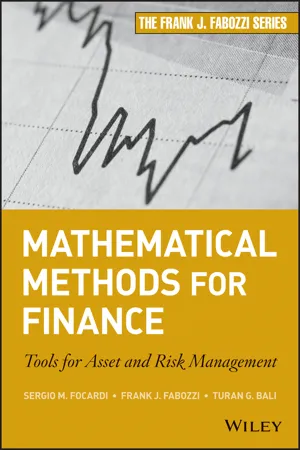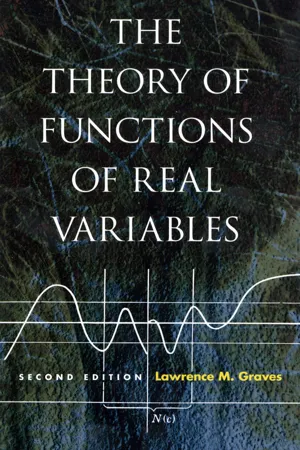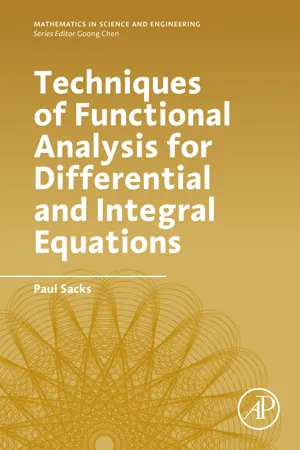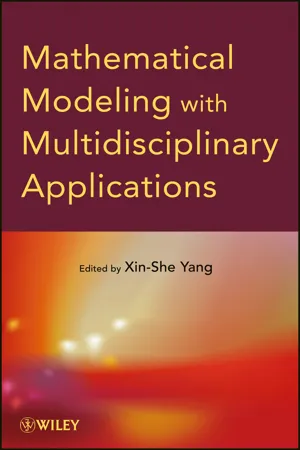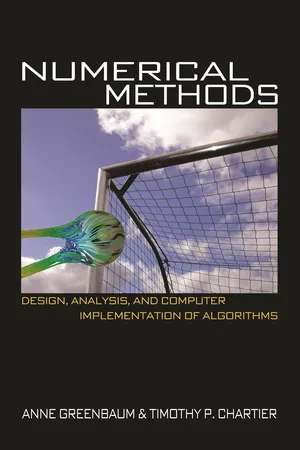Mathematics
Particular Solutions to Differential Equations
Particular solutions to differential equations are specific solutions that satisfy the given initial conditions or boundary conditions. They are obtained by integrating the general solution and then applying the given conditions to determine the specific values of the arbitrary constants. These particular solutions provide the exact solution to the differential equation for the given scenario.
Written by Perlego with AI-assistance
Related key terms
Related key terms
1 of 4
Related key terms
1 of 3
7 Key excerpts on "Particular Solutions to Differential Equations"
- eBook - ePub
- Clayton R. Paul(Author)
- 2011(Publication Date)
- Wiley-IEEE Press(Publisher)
to use mathematical skills to determine what the equations governing the system are telling us about how the system behaves.4.2 WHERE THEY ARISE: THE MEANING OF A SOLUTIONIn Chapter 1 we showed examples of where differential equations arise in electrical and mechanical engineering systems. Ordinary differential equations can be found routinely in all of engineering.How do we know that a particular formula for x(t) is a solution to the differential equation? The simple method is to substitute it into the differential equation, perform the required differentiations, and see if satisfies the equation [i.e., both sides of (4.1) are the same]. However, unlike algebraic equations, differential equations have an infinite number of possible solutions. So we need some additional information to pin down which of these is the actual solution for the problem we are investigating. This additional information comprises what are called the initial conditions for the specific problem being investigated. For example, consider the first-order equation in (4.1a). For the specific problem that this differential equation describes, we would need to specify an additional initial condition for the value of x (t) at some starting time, say t = 0, which we denote as x (0). So the complete specification of the problem would be to specify (a) the differential equation and (b) the initial condition as(4.1a)Once we have obtained a solution x(t) that satisfies this differential equation and the initial condition, we can say that the solution x(t) is valid for all t ≥ 0. Similarly, the second-order equation in (4.1b) requires two initial conditions: x(0) and its derivative att = 0,dx(t)/dt\t=0 ≡ - eBook - ePub
Mathematical Methods for Finance
Tools for Asset and Risk Management
- Sergio M. Focardi, Frank J. Fabozzi, Turan G. Bali(Authors)
- 2013(Publication Date)
- Wiley(Publisher)
The solutions to a differential equation or system of differential equations can be as simple as explicit formulas. When an explicit formula is not possible to obtain, various numerical methods can be used to approximate a solution. Even in the absence of an exact solution, properties of solutions of a differential equation can be determined. A large number of properties of differential equations have been established over the last three centuries. In this chapter, we provide only a brief introduction to the concept of differential equations and their properties, limiting our discussion to the principal concepts. We do not cover stochastic differential equations.DIFFERENTIAL EQUATIONS DEFINED A differential equation is a condition expressed as a functional link between one or more functions and their derivatives. It is expressed as an equation (that is, as an equality between two terms). A solution of a differential equation is a function that satisfies the given condition. For example, the conditionequates to zero a linear relationship between an unknown function Y (x ), its first and second derivatives Y′ (x ), Y ″ (x ), and a known function b (x ). (In some equations, we denote the first and second derivatives by a single and double prime, respectively.) The unknown function Y (x ) is the solution of the equation that is to be determined.There are two broad types of differential equations: ordinary differential equations and partial differential equations. Ordinary differential equations are equations or systems of equations involving only one independent variable. Another way of saying this is that ordinary differential equations involve only total derivatives. In contrast, partial differential equations are differential equations or systems of equations involving partial derivatives. That is, there is more than one independent variable.ORDINARY DIFFERENTIAL EQUATIONS In full generality, an ordinary differential equation (ODE) can be expressed as the following relationship:where Y(m )(x ) denotes the m th derivative of an unknown function Y (x ). If the equation can be solved for the n - eBook - ePub
The Theory of Functions of Real Variables
Second Edition
- Lawrence M Graves(Author)
- 2012(Publication Date)
- Dover Publications(Publisher)
CHAPTER IX ORDINARY DIFFERENTIAL EQUATIONS1. Conditions Ensuring the Existence of Solutions. —In the following we shall let x denote the single real independent variable, and let y denote the dependent variables, of which there may be any finite number. Derivatives with respect to x will be denoted by accents. Thus a system of differential equations involving only first derivatives may be written in the formAn equation or a system of equations involving derivatives of higher orders may always be reduced to a system of the form (1:1) by the introduction of new dependent variables. For example, consider the equationIf we set y1 = y, y2 = y′, equation (1:2) is equivalent to the systemWe shall begin by considering systems of the formin which the derivatives are expressed explicitly as functions of x and y. Here it is understood that the number of equations is the same as the number of dependent variables y which are to be determined as functions of x. If there is only one equation and one variable y, the equation (1:4) may be pictured as attaching to each point in a region of the xy-plane a line whose slope is f(x, y). The problem of solving the differential equation is that of finding a curve having as its tangent at each point the line attached to that point. The extension of this geometrical interpretation to more dimensions is immediate.By a solution of (1:4) we shall mean a differentiable function y(x) defined on an (open or closed) interval (a, b) and such that y′(x) = f(x, y(x)) identically on (a, b). The set of all points (x, y(x)) with x on (a, b) is called thegraphof the solution. There will in general be infinitely many solutions. If we adjoin to the differential equation (1:4) initial conditions of the form y(ξ) = η, then the solution on an interval (a, b) containing ξ is uniquely determined, provided the function f has suitable properties. The requirement that the solution shall satisfy the initial condition y(ξ) = η is expressed geometrically by saying that the graph of the solution shall pass through the point (ξ, η). We shall be interested in studying the properties of the solution as a function y(x, ξ, η) of x and these initial values. The variables ξ and η constitute a special choice of the constants of integration, convenient for theoretical purposes. In a sufficiently restricted domain the complete family of solutions is obtained with the value of ξ fixed. In the first theorem to be proved the domain of the function f - Paul Sacks(Author)
- 2017(Publication Date)
- Academic Press(Publisher)
Chapter 1Some Basic Discussion of Differential and Integral Equations
Abstract
This chapter provides an introduction to the main types of problems which motivate the techniques developed throughout the textbook. Some general discussion of problems involving ordinary differential equations, partial differential equations, and integral equations is given, in order to establish notations, review needed background material, and explain some of the basic ways that such problems are classified. The chapter concludes with some discussion of the concepts of well-posed and ill-posed problems.Keywords
Differential equation; Integral equation; Characteristics; Boundary conditions; Laplace equation; Heat equation; Wave equation; Well-posed problemIn this chapter we will discuss “standard problems” in the theory of ordinary differential equations (ODEs), integral equations, and partial differential equations (PDEs). The techniques developed in this book are all meant to have some relevance for one or more of these kinds of problems, so it seems best to start with some awareness of exactly what the problems are. In each case there are some relatively elementary methods, which the reader may well have seen before, or which rely only on simple calculus considerations, which we will review. At the same time we establish terminology and notations, and begin to get some sense of the ways in which problems are classified.1.1 Ordinary Differential Equations
An n th order ordinary differential equation for an unknown function u = u (t ) on an interval( a , b ) ⊂ Ris any equation of the formF ( t , u ,u ′,u ″, … ,u) = 0( n )(1.1.1)where we use the usual notationsfor derivatives of orderu ′,u ″, …1 , 2 , …and also u(n )for derivative of order n- Gregory Baker(Author)
- 2016(Publication Date)
- WSPC(Publisher)
Linear Partial Differential Equations 44.1Diffusion: Part I
Ordinary differential equations arise in two natural circumstances: quantities that change only in time without spatial variation and quantities fixed in time but vary spatially. Chapter 1 considered cases where spatial variation is ignored and quantities only change in time, for example, in situations where concentrations may be considered uniform in space because they are well stirred. Chapter 3 considered cases where quantities do not change in time, but have spatial variation, for example, in steady state distributions of concentrations. Now we are ready to face the differential equations that describe how spatially varying profiles can change in time.If we are going to address how quantities move through space and change in time, then we will need mathematical models that contain functions of both space and time. It is not surprising then, that these models will contain derivatives both in space and in time and that these derivatives will be partial derivatives. The differential equations that arise will contain partial derivatives and hence are called partial differential equations.By now it should be clear that mathematical models require more than just differential equations. They require initial conditions and boundary conditions, and both are needed for partial differential equations, but there is an important difference in the nature of these conditions that must be acknowledged. Suppose we have a partial differential equation that contains a single time derivative and two spatial derivatives. Because we have a single time derivative, we anticipate the need for an initial condition. So how do we describe the initial state? Since the unknown quantity has a spatial profile that changes in time, we must know the initial spatial profile! In other words, the initial condition requires the initial profile, a function of space.- Xin-She Yang(Author)
- 2013(Publication Date)
- Wiley(Publisher)
PART I
INTRODUCTION AND FOUNDATIONS
Passage contains an image
CHAPTER 1
DIFFERENTIAL EQUATIONS
XIN-SHE YANG School of Science and Technology, Middlesex University, London, UK Also Mathematics and Scientific Computing, National Physical Laboratory, UKThe main requirement for this book is the basic knowledge of calculus and statistics as covered by most undergraduate courses in engineering and science subjects. However, we will provide a brief review of mathematical foundations in the first few chapters so as to help readers to refresh some of the most important concepts.Most mathematical models in physics, chemistry, biology and many other applications are formulated in terms of differential equations. If the variables or quantities (such as velocity, temperature, pressure) change with other independent variables such as spatial coordinates and time, their relationship can in general be written as a differential equation or even a set of differential equations.1.1 ORDINARY DIFFERENTIAL EQUATIONS
An ordinary differential equation (ODE) is a relationship between a function y(x) of an independent variable x and its derivatives y′, y″, …, y(n). It can be written in a generic form(1.1)where Ψ is a function of x, y, …, and y(n). The solution of the equation is a function y = f(x), satisfying the equation for all x in a given domain Ω. The order of the differential equation is equal to the order n of the highest derivative in the equation. Thus, the so-called Riccati equation(1.2)is a first-order ODE, and the following equation of Euler-type(1.3)is a second order. The degree of an equation is defined as the power to which the highest derivative occurs. Therefore, both the Riccati equation and the Euler equation are of the first degree. An equation is called linear if it can be arranged into the form(1.4)where all the coefficients depend on x only, not on y or any of its derivatives. If any of the coefficients is a function of y or any of its derivatives, then the equation is nonlinear. If the right-hand side is zero or ϕ(x) = 0, the equation is homogeneous. It is called nonhomogeneous if ϕ(x- eBook - ePub
Numerical Methods
Design, Analysis, and Computer Implementation of Algorithms
- Anne Greenbaum, Tim P. Chartier(Authors)
- 2012(Publication Date)
- Princeton University Press(Publisher)
14
NUMERICAL SOLUTIONPARTIAL DIFFERENTIALEQUATIONS
Previous chapters have dealt with differential equations in a single independent variable. Chapter 11 dealt with time-dependent problems, while chapter 13 dealt with problems having a single spatial variable. In this chapter we will combine the two and deal with problems whose solutions depend on both time and space and/or on more than one spatial variable. These problems will be described by partial differential equations .A general second-order linear partial differential equation in two independent variables x and y can be written in the formwhere the coefficients a , b , c , d , e , f , and g are given functions of x and y . The equation is classified as one of three types, based on the discriminant , D ≡ b 2 − ac : If D < 0, the equation is elliptic; if D = 0, it is parabolic; and if D > 0, it is hyperbolic. Sometimes problems are of mixed type because the discriminant has one sign in one part of the domain and a different sign in another part. Note that the lower-order terms (those involvingux,uy, and u ) are ignored in this classification.The prototype of an elliptic equation is Poisson’s equation:(Here b = 0 and a = c = 1, so that D ≡ b 2 − ac = −1.) In the special case where g ≡ 0, this is called Laplace’s equation. An elliptic equation with constant coefficients can be transformed to Poisson’s equation by a linear change of variables. Elliptic equations usually define stationary solutions that minimize energy.The prototype of a parabolic equation is the heat equation (also called the diffusion equation ):SIMÉON -DENIS POISSONSiméon-Denis Poisson (1781–1840) drew the attention of his teachers, Laplace and Lagrange, for his mathematical abilities as a student at the École Polytechnique. Legendre’s attention was caught by the 18-year-old’s memoir on finite differences. His rigorous studies in Paris started a productive career that led to between 300 and 400 mathematical works. The breadth of his accomplishments is reflected in the many areas in which his name appears: Poisson’s integral, Poisson’s equation in potential theory, Poisson brackets in differential equations, Poisson’s ratio in elasticity, and Poisson’s constant in electricity, to name just a few.
Index pages curate the most relevant extracts from our library of academic textbooks. They’ve been created using an in-house natural language model (NLM), each adding context and meaning to key research topics.
Explore more topic indexes
Explore more topic indexes
1 of 6
Explore more topic indexes
1 of 4

